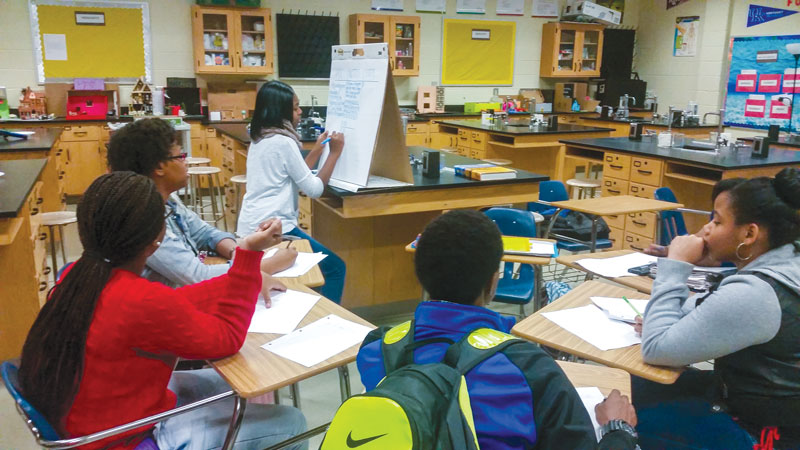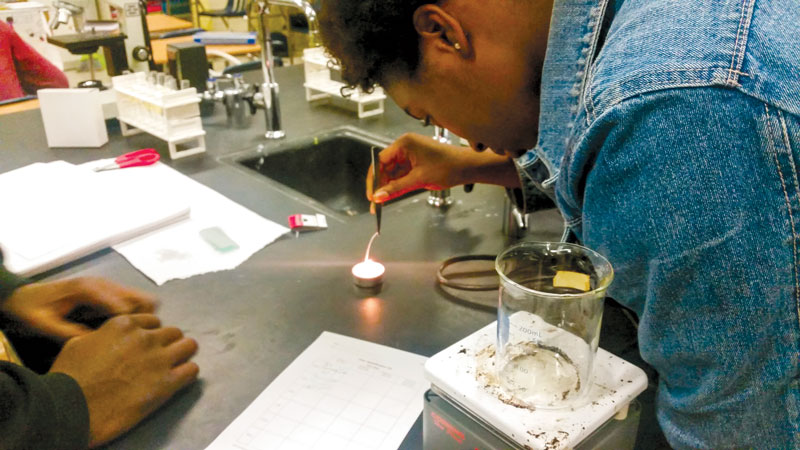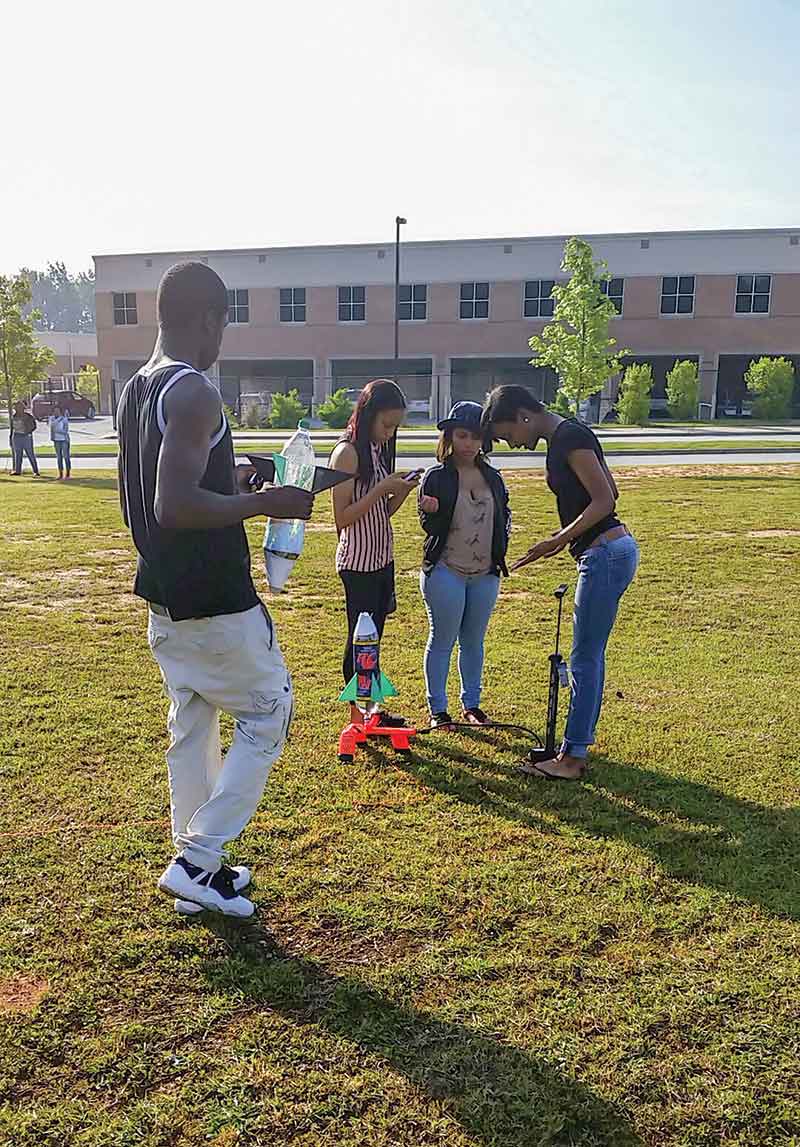Teach For America: Tips to Apply
Spring
2019
Professional Development - Tips to Build Your Career
Teach For America: Tips to Apply
Kayla Stephens, Programs Manager, Society of Physics Students & Teach For America Alum
 Nelson Mandela once said, “Education is the most powerful weapon which you can use to change the world.” Although it has been over 60 years since Brown v. Board of Education, the United States still struggles with the concept of integrated and equal schooling. The potential of each student across the country is equal; however, access to opportunities remains disproportional.
Nelson Mandela once said, “Education is the most powerful weapon which you can use to change the world.” Although it has been over 60 years since Brown v. Board of Education, the United States still struggles with the concept of integrated and equal schooling. The potential of each student across the country is equal; however, access to opportunities remains disproportional.
This is especially true in physics, where students in many parts of the country don’t have access to advanced math and science classes. Often this is because there are not enough teachers. In the United States, studies show a need for qualified high school physics teachers. Compared to other core subjects, physics has the second-lowest percentage of teachers with a degree in their content area—less than 50 percent. With a rising number of students enrolling in physics, it is important to meet that demand and ensure academic achievement.1
Since 1990, Teach For America (TFA) has recruited almost 60,000 college graduates with the mission to close the opportunity gap for all children. Selected corps members commit to at least two years of teaching in under-resourced communities. Recruits are placed based on academic background, interest, the specific needs of their preferred geographic regions, and where they will have the biggest impact on student outcomes. Since physics majors have strong backgrounds in mathematics and physics, they are most likely to teach those or similar disciplines. There is a high demand for STEM teachers, especially in under-resourced areas, and TFA is consistently working to increase the supply of qualified teachers in these subject areas.2
Teach For America’s hope for their corps members is that they stay in education or use their career to continue to advocate for educational equity. The TFA program is selective and holds a high bar for admission, with an acceptance rate averaging between 11 and 15 percent. This is not meant to be intimidating but to show that preparation is key. If TFA is a potential next step for you after graduation, use the following tips to help you stand out as a top candidate.
Find out if Teach For America Is for You
The application and interview process for TFA is quite rigorous and can take a significant amount of time and preparation. Before beginning the process, assess whether their mission and values align with your own.
• Meet with a recruiter: If a campus recruiter has not reached out to you yet, you can look on TFA’s website (teachforamerica.org) to find a recruiter near you. Recruiters are most likely alumni themselves and can be a major resource, providing support for you throughout the application process. Speaking with a recruiter can help you understand the mission of TFA and what role you can play.
• Reach out to current corps members or alumni: This is another great way to receive tips and support during the application process. You can gain a genuine perspective on experiences in the classroom and what kind of training corps members experience. This is also an opportunity to gain insight into the rewarding aspects of teaching with TFA, as well as the challenges you may face. If you personally do not have any contacts, your recruiter may be able to connect you with some.
• Visit a nearby TFA school: Your recruiter may be able to help you organize a visit to a nearby school that employs TFA corps members. A corps member may even be able to host you during your trip. This will give you more of a hands-on view of life as a TFA teacher.
The Application—Resume and Written Responses
There are certain characteristics that Teach For America is looking for in their applicants, such as leadership experience, academic achievement, perseverance, interpersonal skills, respect for diverse groups, and importantly, your passion for making sure that all children have equal opportunity to succeed. The experiences in your resume and written response should highlight these qualities. This application is TFA’s first impression of you and a determining factor for whether you will be invited to an in-person interview.
• Be concise and to the point: Teach For America can receive almost 60,000 applications in a year. It is important that your achievements are clearly seen in your resume and written responses. The website (teachforamerica.org) has tips on what they are looking for and provides articles written by other corps members on the skills you want to hone and share. Also, refer to the Winter 2018 issue of the SPS Observer Professional Development section for more tips on how to effectively build your resume.
• Review and edit: Before you apply, have your resume and your written responses reviewed and/or edited by multiple sources. This can ensure that the important information is easy to find and that your documents are clear of spelling, grammar, and formatting errors.
• Apply early: Teach For America provides five application windows and you can apply in any one of them. However, once you’re accepted to TFA, there are still additional steps you must take to ensure that you are eligible to be placed in a school. For example, to qualify to teach, each state has their own state exam that you will have to pass before you’re allowed in the classroom. It can take time to retrieve your results, so it is best to do this early in case you have to retake a test. Plus, applying in an earlier time window will help you solidify your plans after graduation.
Prepare for the Interview
This is the fun part of the application process! During the in-person interview, you will participate in a group activity with other applicants, teach a five-minute lesson of your choice in front of the group, and finally, have your one-on-one interview. This may sound intimidating, but if you prepare ahead of time and be yourself, it can be enjoyable.
• Practice your lesson: It is important not to overcomplicate your lesson. Keep the topic as simple and engaging as possible. Remember, you only have five minutes—you want to pick a topic that will be easy to grasp. Consider using one of the demos from the SPS Library! (See spsnational.org/programs/outreach/demonstrations.) Involve your audience in the lesson as well. Practice with your friends and get their input prior to your interview.
• Be yourself! This is the chance for the interviewers to get to know who you really are and to get a grasp of your interpersonal skills. They want to see that you can be a leader as well as a team player. And remember, they are human just like you!
Visit teachforamerica.org to get more information on the work they do, who they are looking for, and how you can apply. Also, take the time to read articles written by TFA alum, such as “Rocket Scientist to STEM Teacher: Why I Chose to Teach For America” by Natalia Chabebe.
For more information on resumes and professional development resources, visit spsnational.org/careers.
Other popular alternative teaching programs: American Board (americanboard.org) The New Teacher Project (tntp.org)
References
1. “U.S. Physics Teacher Shortage and the Need for PhysTEC.” Physics Teacher Education Coalition – Improving the Education of Future Physics Teachers, 2019. http://www.phystec.org/webdocs/shortage.cfm.
2. Teach for America. 2012–2013 Teach for America Annual Letter. Durham, NC, 2013. https://www.teachforamerica.org/sites/default/files/teach_for_america_fy12–13_annual_letter.pdf.



